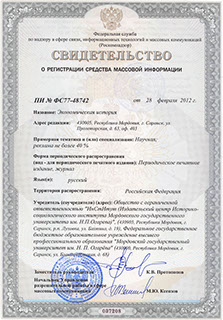Экономическая историЯ
Russian Journal of Economic History
ISSN 2409-630X (Print)
ISSN 2618-916X (Online)
Expert board:
- Scientific Council of RAS on economic history;
- Research and Educational Center «The economic history of Central Russia and the Middle Volga region» of Ogarev Mordovia State University;
- Center of Economic History of Lomonosov Moscow State University
Navigation
Certificate of registration

Maria V. Kartashova
Balakhna Museum of History and Art Complex Saransk, Balakhna, Russia, e-mail: kmiw@mail.ru
IMPLEMENTATION OF STATE POLICY ON TECHNICAL EDUCATION PEASANT-HANDICRAFTSMEN IN THE RUSSIAN EMPIRE IN THE LATE XIX – EARLY XX CENTURY
The article analyzes the activities of the four kinds of handicraft training schools and workshops: public, private, zemsky and workshops belonging to various public organizations (societies, artisanal committees). The article also considers the funding of workshops, the structure of students. It marked the largest number of workshops in the group of fiber processing crafts such as weaving and lace making.
Territorially private artisanal schools and workshops covered a large area of the European part of empire. The largest numbers of them were concentrated in Moscow, St. Petersburg province, Finland. For the purpose of crafts imposition (for example, in Siberia, Far East, Middle Asia) or its development (in the Caucasus, Polish Kingdom), the government has organized workshops on the outskirts of country. Zemsky handicraft workshops were the most widespread type, because zemstvos not only executed government orders for the crafts development, but persecuted commercial purposes as well as private. Not all schools were popular among the peasant population. A special need in these institutions was observed on newly reclaimed lands of Siberia. Most workshops were subsidized and supervised by the agricultural department in the framework of public policies to raise the technical level among the handicraftsmen.
During the First World War, the Ministry of Agriculture was reviewing its program for technical training of handicraftsmen and making a bet not on the younger generation, but on the training of the «crippled» soldiers to ensure their work and earnings. In general, the activities of government on the development of technical education among artisanal peasants were aimed at the maintaining and planting of handicrafts in the empire.
Keywords: Russian Empire, the state policy, the agricultural department, technical education, handicraft training workshops, handicrafts, craftsmen, zemstvo.
© Ogarev Mordovia State University. History and Sociology Institute, 2017
68, Of. 411, Bolshevistskaya St., 430005, The editorial office of the scholarly journal «Russian Journal of Economic History»
Tel.: (8342) 24-25-90; 27-07-11, Fax: (8342) 24-25-90, E-mail: jurnal-econom-hist@isi.mrsu.ru
Designed by A. Napalkov, Email: napalkov@isi.mrsu.ru

